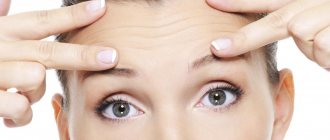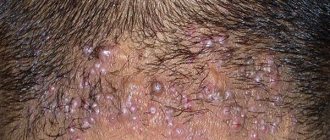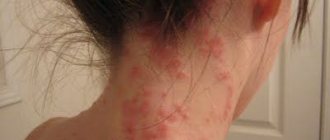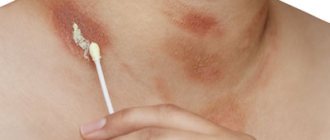Last update: 11/25/2019
Author of the article:
Menshchikova Galina Vladimirovna
Dermatovenerologist, trichologist, candidate of medical sciences, member of the Association “National Society of Trichologists”
If your luxurious hair begins to fade and thin, and your skin is unpleasantly itchy and flaky, it’s time to pay attention to the condition of the epidermis - perhaps you have become a target of scalp fungus.
Diseases caused by fungal bacteria have been known to medicine for a long time, but, unfortunately, it is not possible to prevent their spread. Despite significant technical progress, mushrooms not only did not sink into oblivion, but also rapidly multiplied in conditions of deteriorating ecology and active urbanization. To date, there is evidence of more than one and a half million types of infections caused by fungi.
The causative agent of the pathological process on the scalp is the yeast fungi Pityrosporumovale - natural components of the microflora of the skin of a healthy person. Systemic disorders in the body can cause an excessive increase in the number of fungal bacteria, which, in turn, leads to the development of seborrheic dermatitis of the scalp.
Diagnosis of the disease
The skin fungus itself, which can cause discomfort, has varieties. Having identified the symptoms, the attending physician will be able to individually select therapy for the patient, suggest an effective way to cure the fungus and avoid its recurrence in the future. Given the infectious nature of the disease, it is easily transmitted through the common use of personal hygiene items and hats.
Adults and children must maintain personal hygiene to avoid becoming infected. This is especially true for people visiting swimming pools and saunas.
If a fungus is found in one family member’s house, you need to disinfect common items, allocate towels and bed linen, and wash clothes separately.
Next, do some general cleaning and monitor the health of the rest of the family.
Hygiene rules during illness
Washing and storing the linen of a sick person should be done separately from the linen of other people. Before washing, dirty laundry is boiled in a soap solution for 15 minutes, and after washing it is thoroughly ironed. The floors in the apartment should be washed daily with hot water and soap. To prevent the spread of infection, the patient must always wear a hat that tightly covers the scalp. A large amount of dust should not be allowed in the room where the patient is located, since dust is a source of pathogenic fungal spores.
The patient is recommended to wash his hair every 2 days for dry hair, and daily for oily hair, since dirty hair provides a favorable environment for the rapid proliferation of fungi .
Symptoms of scalp fungus
The specific symptoms that a person will experience depend on the type of fungal infection. However, there are common signs that indicate the presence of a fungus on the scalp. This:
- deterioration of hair condition – loss of shine, hair loss, dryness, dull color;
- peeling of the skin, identification of individual flaky areas of a round shape with unclear contours;
- in areas affected by the fungus, hair thins and falls out until bald patches appear;
- pink plaques stand out above the surface of the scalp, which can become covered with bubbles of liquid, yellowish and grayish crusts;
- hair becomes brittle at the root, falls out and leaves behind blackheads;
- If a person has ringworm, this is indicated by local purulent skin lesions.
In the initial stage of infection, symptoms may not be obvious, so it is difficult to start treatment on time. You can diagnose the presence of problems at home by the abundant appearance of dandruff, if this has not previously been observed.
First aid upon detection
Mycosis is a skin disease of infectious origin caused by opportunistic or pathogenic harmful microorganisms.
If the disease is not diagnosed in time, it becomes chronic and becomes dangerous. The disease can affect the scalp, arms, legs, face, and genitals (both external and internal). That is why, when identifying the first signs of the disease, in order to avoid negative consequences, you must immediately consult a doctor.
Note! You cannot start treatment on your own, as this can lead to serious complications!
Self-treatment can only remove visible traces of the disease; the disease will “hide”, but will progress inside the body. Only a specialist can correctly diagnose and prescribe the necessary therapy.
Types of fungus on the head
Microsporia is a fungal disease that can spread quickly. The symptomatology of this fungus is the presence of redness on the scalp, which may become covered with blisters. At the site of the lesion, the hair becomes brittle and falls out.
Trichophytosis, or ringworm, is manifested by flaking, itching of the skin, the appearance of red spots and brittle hair. A grayish coating forms in place of broken hairs. In the deep form of trichophytosis, swellings with clear red contours, covered with blisters containing purulent content, are revealed on the skin. Advanced ringworm is characterized by general weakness, the appearance of rashes on the body, swollen lymph nodes, and deformation of the nails.
Favus or scab is a disease that is rare in our area. More often, residents of the Middle East and Asian countries suffer from it. The onset of the disease is characterized by the appearance of yellowish crusts on the scalp, which without treatment can spread over the entire surface. Under the crusts, the hair atrophies, falls out, and the person goes bald.
Trichophytosis
Trichophytosis is a fungal disease that most often affects the skin and hair, and less often the nails.
Trichophytosis of the scalp
The causative agent is the fungus Trichophyton, from which the name of the disease comes. Infection occurs through direct contact with a sick person, as well as with his personal belongings. A special source of the disease are personal hygiene items, as well as hats, combs, scarves, scissors, and bedding. Rarely, transmission of the disease occurs in hairdressing salons, kindergartens, sanatoriums, boarding schools, and schools. Animals can also be carriers of the fungus - especially rodents (mice, rats) and cattle (most often calves).
Infection of a person from an animal occurs through contact with hay, dust, contaminated hair affected by the fungus, and much less often through direct contact between a person and an animal. This disease is most often diagnosed in the fall.
Treatment of fungus on the head
Due to the difficulty of diagnosing the disease, prescribing yourself an ointment or other remedy for fungus is a risky activity, since incorrect therapy will only worsen the course of the disease. Depending on the type of mycosis, the doctor will tell you how to treat the fungus on the head, for how long and in combination with what procedures.
It is difficult to choose a medicine if you have a scalp fungus; there are many remedies for a fungus on the head, but many of the drugs taken orally have contraindications. Thus, most of them are not recommended for use by anyone who has blood diseases, kidney problems, cancer, or metabolic disorders.
In addition to tablets taken orally, there are a number of drugs used locally. These are medicinal shampoos Mycozoral, Keto Plus, Sebozol, Nizoral and their analogues.
Before choosing how to treat a scalp fungus, your dermatologist will determine the type of infection. Microsporia is treated with Termicon and Terbizil ointments, which are applied to the lesions twice a day. Apply a thin layer of ointment to the affected area and rub gently. Course – up to 4 weeks. At the same time, they may prescribe oral administration of the drug Griseofulvin 3 times a day. For better absorption, Griseofulvin is taken with a teaspoon of sunflower oil. The duration of therapy will be determined by the doctor, usually up to 2 months.
Trichophytosis is treated with Microspor ointment, which is applied to the affected area once a day for 2 weeks. An advanced disease that has become chronic is treated using the Arievich method to exfoliate the stratum corneum. To do this, make a compress of milk-salicylic ointment, which is applied for 2 days. After two days, apply a compress with salicylic-zinc or salicylic ointment. After the compresses, the doctor will remove the stratum corneum and the remaining blackheads from the hair.
Favus is treated in a similar way to trichophytosis. Treatment is supplemented by taking Irunin orally once a day for 3 weeks. Batrafen ointment can be applied to the affected areas of the skin 2 times a day. Course – 2 weeks.
Causes of appearance and methods of infection
The fungus exists in the form of mycelium (the vegetative form of microorganisms) and spores.
Therefore, before you begin to treat a fungal infection that has affected the scalp, it is necessary to determine the form of mycosis and the causes of the development of the pathology.
The disease can be caused by the following factors:
- Blood diseases.
- Deterioration of the cardiovascular system.
- Development of cancer.
- Increased sweating.
- Weakening of the protective functions of the immune system due to serious illnesses.
- Deterioration of the intestinal microflora.
- Problems with the metabolic process.
- Hair can often suffer from poor environmental conditions in the area where you live.
- Constant stress.
- Overheating or hypothermia of the body.
- Exposure of the body to ultraviolet rays for a fairly long period of time.
- Failure to comply with personal hygiene rules.
Attention!
For some people, individual intolerance to hormonal or antibacterial therapy can lead to hair fungus. Sometimes mycosis can result from close contact with infected people or stray animals. This cause is especially common in young children.
When identifying this disease, regardless of its cause, you should not self-medicate, because incorrectly selected antifungal medications can aggravate the problem.
Treat scalp fungus with folk remedies
Mild forms of fungal infection can be easily eliminated if treatment with folk remedies is combined with medications. Eucalyptus oil has an effective effect against mycosis. It relieves itching and irritation. It is necessary to apply a few drops of oil to a comb or comb and comb your hair, being careful not to injure the skin on your head.
Another effective remedy for relieving fungal symptoms is prepared from garlic, lemon and oil. You need to take 1 tsp. olive oil, garlic juice, lemon juice. Mix everything, then dip a cotton pad in the resulting mixture and gently rub the mixture into the affected areas. Then you need to cover your head with film, wrap it in a towel and leave for an hour.
Tingling is considered a normal reaction. After the time has passed, wash your hair with regular shampoo; for rinsing, take a liter of water with the addition of 2 tbsp. vinegar. You need to repeat the procedure every time you plan to wash your hair. From the first use, the symptoms subside, after 4 times the hair looks much healthier. The downside of this method is the garlicky smell that comes from wet hair.
Folk remedies
All folk remedies involve the use of simple ingredients. The simplest recipe is to mix water and vinegar in a 1:1 ratio. Lubricate the affected areas with this mixture every day, on the 3rd day you will feel relief, and after 2 months the disease will pass.
An effective remedy would be an infusion of tansy. To prepare it, take 1 tbsp. l. tansy, place in a bowl and fill with boiling water in a volume of 400 ml. Cover the dish with a lid and cool for 2 hours. After which the infusion is filtered and the hair is washed with it without using shampoo for a month.
Another available recipe is to prepare a decoction of lemon peels. To do this, remove the peel from 4 lemons, add a liter of water and boil for 15 minutes over low heat. After the broth has cooled, you can rinse your hair with it after washing once a week.
Most folk recipes are not so effective; it is easier to buy antifungal shampoo at the pharmacy than to make tinctures and ointments. Giving preference exclusively to traditional recipes, ignoring doctor’s recommendations, is a mistake.
Supplementing the course of treatment with traditional medicine recipes is a way to speed up the healing process and prevent relapses of the disease. After treatment, folk remedies can be used from time to time as prophylaxis, not forgetting about hygiene and proper nutrition.
Prevention
The following measures are taken for prevention:
- avoid contact with random street animals;
- constantly observe the rules of personal hygiene;
- do not use other people's personal belongings;
- do not neglect the symptoms of fungal diseases;
- try to avoid stressful situations;
- do not overwork;
- do not be exposed to ultraviolet radiation;
- do not use cosmetics of dubious quality;
- take vitamins;
- take medications containing sulfur;
- do not contact with infected people.
Treatment of mycosis of hair should be carried out by a specialist who will select suitable medications and recommend traditional medicine. After all, self-medication can lead to the development of side effects and complications.










